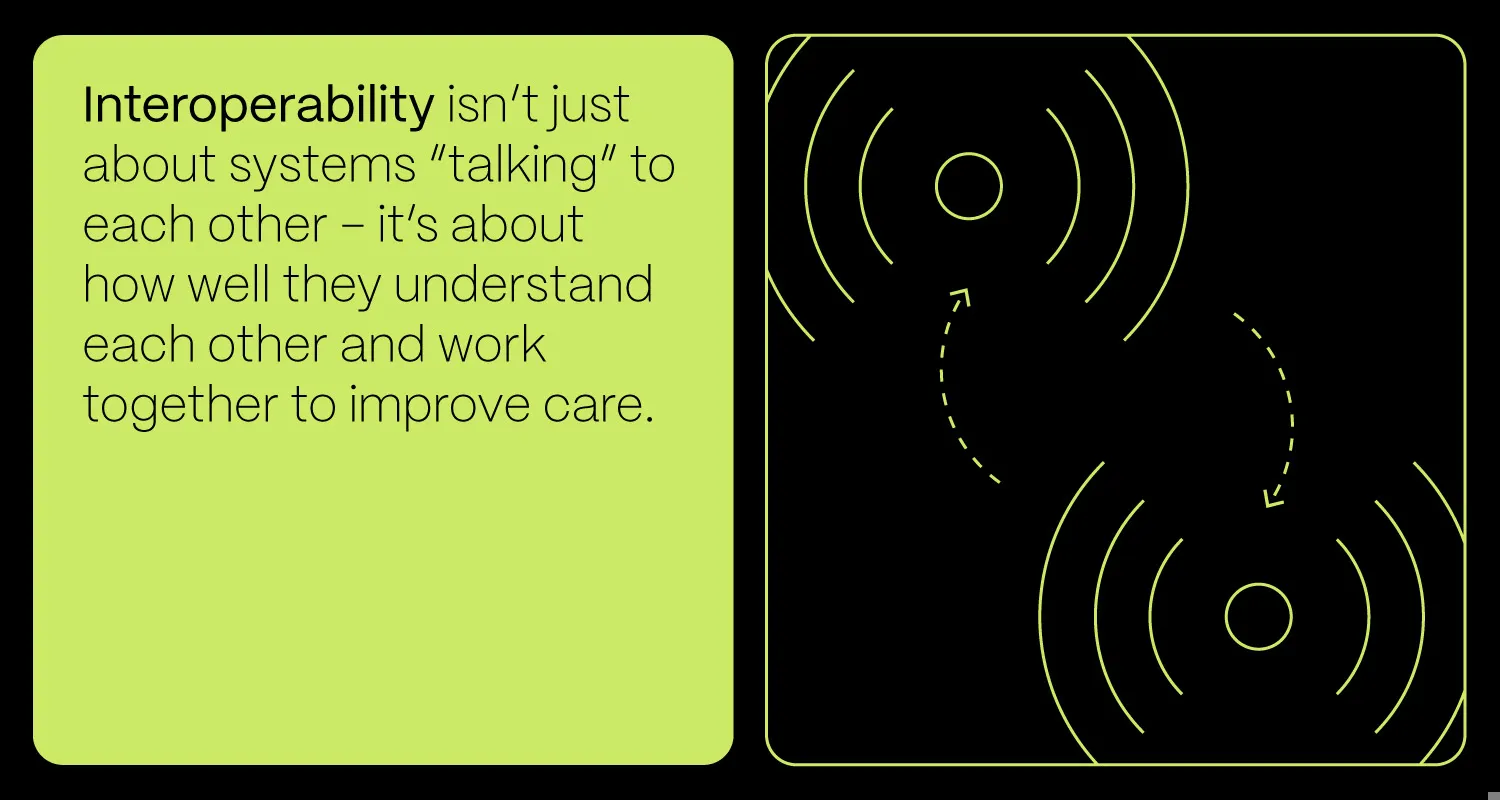Interoperability: The missing link in modern healthcare

When healthcare systems, apps, and devices can talk to each other, understand one another, and share information safely – that’s interoperability. It means data can move smoothly between platforms. Instead of repeatedly entering the same details or relying on assumptions about prior care, clinicians can work with accurate, up-to-date information from the start.
When systems are connected, healthcare providers get the full picture. That leads to better decisions, safer care, and fewer mistakes. It also saves time, reduces costs, and, most importantly, helps people get the care they need.
In this article, we’ll take a closer look at the different types of interoperability, why it often breaks down, the standards that make it possible, and what healthcare organisations and development teams can do to move forward.
Main types of interoperability in healthcare
Interoperability isn’t just about systems talking to each other – it’s about how well they understand each other and work together to improve care. There are four key levels to know:
Foundational interoperability
At this basic level, systems can send and receive data, but they don’t necessarily interpret it. For instance, a lab sends a PDF of test results to a hospital system. In this case, the data is received, but hospital staff may still have to manually enter and analyse the results themselves.
Structural interoperability
Here, data is exchanged in structured formats (such as HL7 or FHIR) so that systems can interpret and automatically organise and display it. A blood pressure reading, for example, always ends up in the right field with the correct units. This way, manual data entry is avoided and errors are reduced.
Semantic interoperability
This is the highest level of interoperability in healthcare. It’s where systems understand and use the data in a meaningful way. Shared medical vocabularies (like SNOMED CT) enable systems to recognise that “hypertension” and “high blood pressure” mean the same thing, and act on that info accordingly.
Organisational interoperability
Organisational interoperability has nothing to do with systems or software, but with policies, regulations, and governance. It’s about making sure data sharing is backed by clear rules, shared responsibility, and strong collaboration between healthcare organisations.
What’s blocking interoperability?
Even today, many healthcare systems (EHRs, lab systems, wearables, etc.) don’t communicate or exchange data effectively. When they don’t connect, clinicians can’t have detailed insights into patient data. That means duplicate records, delays, missed details, and in the worst cases, misdiagnosis.
Let’s break down the main blockers:
Vendor lock-in
Many healthcare providers are tied to rigid, expensive systems from specific vendors. The data might be saved in a special format that only that company’s system can understand. New systems might not “talk” to the old one easily.
Switching platforms isn’t just expensive – it also means retraining staff, which takes time and resources. So it’s no surprise that many organisations are reluctant to make a change.
Lack of incentives to innovate
Hospitals often don’t see a quick win from investing in interoperability. There’s no extra funding or pressure to modernise, and improving data sharing doesn’t always lower costs immediately. Add to that a competitive mindset – where some organisations want to “own” patient data – and collaboration becomes even harder.
System fragmentation
Vendor lock-in and lack of incentives for innovation lead to a health tech eco-system made up of many semi-autonomous organisations, each with its own tech decision, inconsistent standards and systems across regions.
Systems were built at different times, with different technologies, vendors and goals. Many were not designed with interoperability in mind.
Who’s shaping interoperability across regions?
Beyond technical standards, legislative bodies play a defining role in shaping how interoperability unfolds in practice.
- EU – The European Health Data Space (EHDS) leads efforts to unify health data access across member states. Backed by the EMA and eHealth Network, it promotes standards like HL7 FHIR, ICD-10, and LOINC for care, research, and policy.
- UK – NHS England and its technology arm, NHS England Transformation Directorate, set the pace with frameworks like the Interoperability Toolkit and standards such as FHIR and SNOMED CT. The UK Code of Conduct for Data-Driven Health and Care Technology provides guiding principles for safe, ethical tech deployment.
- US – Led by the Office of the National Coordinator for Health IT (ONC), the US takes a market-driven approach. Key standards include FHIR, USCDI, and HL7, while CMS supports interoperability through programmes like Meaningful Use and TEFCA.
- Global impact – Bodies like HL7 International, IHE, and SNOMED International shape the global tech landscape. But despite growing alignment, fragmentation remains, fuelled by legacy systems, policy gaps, and uneven investment.
What it takes to get interoperability right
Behind every standard, specification, and regulation lies a very practical need: getting systems to speak the same language.
This is where IT companies and development teams step in. They turn abstract rules into working solutions, connecting platforms, aligning data models, and ensuring secure information flow across the ecosystem.
So, how can tech teams rise to the challenge and build true interoperability into healthcare systems?
Use open standards from the start
Software engineering teams should build APIs using publicly available and widely adopted technical specifications and standards that promote interoperability across systems, devices, and applications.
Standards like FHIR, HL7, and OpenEHR enable consistent, accurate, and secure data exchange, regardless of vendor or platform. Aligning systems with standard medical vocabularies such as SNOMED CT also ensures that data remains consistent, structured, and portable.
Design for easy integration
Development teams implement RESTful APIs with clear versioning and thorough documentation (using tools like OpenAPI or Postman). This simplifies how digital health tools and hospital systems connect, reducing integration friction and making data exchange more reliable across a wide range of applications and devices.
Automate compliance and monitoring
By embedding validation steps into automated CI/CD pipelines, development teams catch errors early – like checking data structures against FHIR specifications. Proactively monitoring integration failures helps resolve issues before they impact patient care, supporting reliability and trust across systems.
Enable smart data translation
Development teams use terminology services and ETL tools to map between formats (e.g. ICD-10 to SNOMED CT, or lab codes to LOINC). This ensures that systems not only exchange data but also interpret it correctly, even when working across different code systems, formats, or languages. Without translation, even shared data can be useless or misleading.
Prioritise the end-user experience
Ultimately, systems should be designed with people in mind. Whether it’s clinicians, administrators, or patients, users need data that is easy to access, clear in context, and trustworthy.
Showing where the data comes from and presenting it in a user-friendly format increases adoption and supports better decision-making. Interoperability should enhance – not complicate – the daily workflows of those delivering or receiving care.
How we can help
We bring in specialised teams who understand both the technical and regulatory demands of healthcare – from medical standards and compliance frameworks to modernising legacy systems.
Here’s how we support your digital transformation:
- designing and building scalable infrastructure that grows with your needs – secure, reliable and ready for future demands;
- developing scalable and modular systems which are designed for easy integration, use open standards from the start, enable smart data translation and prioritise end-user experience;
- automating compliance, monitoring and business workflows and processes
All of this helps lay the groundwork for meaningful, sustainable interoperability that supports better decisions, smoother care, and systems that can grow and adapt over time.



